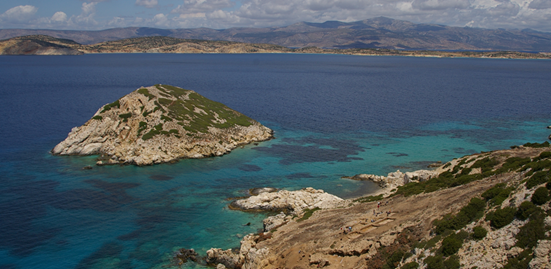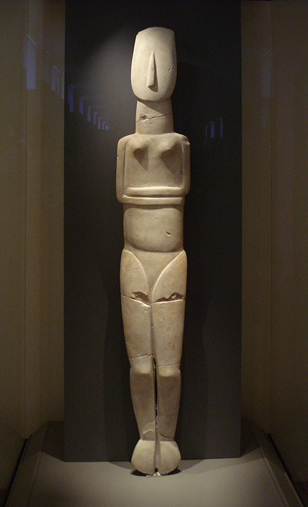Giant marble pyramid-shaped island complex rising from sea uncovered, revealing secrets of ancient Greece’s origins
Exclusive: Thousands of years of history being unlocked in the Aegean isles which could provide groundbreaking knowledge of ancient civilisations
Archaeologists are, for the first time, discovering the probable origins of ancient Greece.
Excavations on a tiny island in the Aegean Sea – 125 miles southeast of Athens – are revealing the earliest truly monumental complex of buildings ever unearthed anywhere in the Greek world.
Dating back 4,600 years, the site may also have been part of the inspiration for a key aspect of Greek religion – the idea that mountain tops were the dwelling places of the gods.
The complex – on a mountain peak-shaped islet off the coast of the Aegean island of Keros (part of the Cyclades archipelago) – is totally changing archaeologists’ understanding of prehistoric Greece.
Until now, nobody had realised the true scale of the complex – and the gargantuan effort that had gone into constructing it.
Archaeologists now believe that, in order to construct the complex, early Bronze Age Greeks embarked on at least 3,500 maritime voyages to transport between 7,000 and 10,000 tonnes of shining white marble from one Aegean island to another.
Each return voyage would have required up to 24 crew members to paddle for around five hours.
“It is by far the largest prehistoric marine transport operation that has ever come to light anywhere in the world,” said Dr Julian Whitewright, a leading maritime archaeologist at the University of Southampton.
“It demonstrates quite clearly just how important, and integral to their culture, seafaring was to these early Bronze Age Aegean people.”
The voyages – totalling around 45,000 miles – allowed the architects to construct what is thought to have been a huge religious sanctuary consisting of up to 60 marble buildings, which were constructed specifically to glisten in the sun.

What’s more, the architects “terra-formed” the pyramid-shaped island “mini-mountain”, known in recent centuries as Dhaskalio (possibly just meaning “islet”), to create around 1,000m of artificial terracing, arranged in six “steps” on its steep slopes.
These roughly six-metre wide terraces appear to have been built specifically to accommodate all the buildings. The summit itself was not initially built on – but instead had a small, probably sacred, open area where votive offerings may have been deposited.
“Our investigation has been transforming our understanding of early Bronze Age Cycladic culture and suggests that these very early Greeks were organisationally, technically and politically much more advanced than previously thought,” said the project’s co-director Michael Boyd, of Cambridge University’s McDonald Institute for Archaeological Research.
Nothing like this monumental complex has ever been found from this period in or around Greece before.
Although the current archaeological investigations on Dhaskalio have been going on for the past four years, it’s only more detailed examination of the resultant data over the past 12 months that has revealed the true scale of the complex, and the transport logistics and construction work associated with it.
But the remarkable nature of the site does fit into a much more widely dispersed series of monumental construction traditions from western Europe and the Middle East.
Intriguingly, it was built within 100 years or so of the creation of Stonehenge, the first Egyptian pyramids, the great cities of the Indus Valley and the first known Mesopotamian kingdoms.
This broader context shows quite clearly that Dhaskalio was part of a much wider cultural and political phenomenon involving huge ultra-ambitious construction and political projects.
These Egyptian, Mesopotamian, Indus Valley and western European traditions were almost certainly not directly related to each other – but were probably the result of a common stimulus, namely the spread and intensification of early metal usage, and the mercantile, cultural and political changes that process triggered.

Equally significantly, Dhaskalio shows that, contrary to previous belief, Greece was part and parcel of that much wider phenomenon.
While the individual buildings on Dhaskalio were not themselves truly monumental, the complex as a whole certainly was.
The 7,000-10,000 tonnes of white marble, needed for the project, were quarried in the southeastern part of Naxos, a large island around 6.5 miles northwest of Dhaskalio. Each return trip from Naxos to Dhaskalio would therefore have been around 13 miles.
Images of Aegean Cycladic boats survive – so it is known that they were each only 10-15m long and capable of carrying only between one and two tonnes of cargo.
The prehistoric Aegean project engineers then had to create the mountainside terraces to accommodate the dozens of white marble buildings – some of which were two storeys and up to 10m long. Because the entire complex was constructed according to a set plan with buildings of very similar design, it is thought that the entire island sanctuary was constructed over a relatively short period – probably between 20 and 40 years.
Its existence – and the huge and consistent organisation of labour and transport that had to be deployed – strongly suggests that there was a strong and stable political entity involved, potentially based on Keros or possibly Naxos.
From the south, the island would have been visible from many miles away as a gleaming white pyramid-shaped mini-mountain rising out of the sea.
It is not known for sure whether the pyramidic shape was in any way significant. But the place had certainly been specifically selected as a religious site in preference to other much higher, more impressive and potentially more accessible mountains that did not have that shape.
What’s more, pyramidic shapes were, at precisely that time, coming to be regarded as sacred just 500 miles to the southeast in ancient Egypt (indeed it is also at that time that there are the first signs of Egyptian influence on nearby Crete).

In the ancient Egyptian context, pyramid shapes were associated with a god of creation, Atum. He was believed to inhabit a pyramid-shaped rock (a “pyramidion” or “Benben” stone) that was seen as symbolising the mythical “primordial mound” (representing the first dry land) which (much as in the book of Genesis) rose out of a “chaotic sea” at the time of creation.
What’s more, that pyramidic stone symbolised the sacred place where the first rays of the sun illuminated the primordial mound at the time of creation – and the pyramidic shape of the pyramidion (the idealised primordial mound) was seen as symbolising the slanting rays of the sun as they descended from the sky to earth.
Indeed, the ancient Egyptians used to cover their symbolic “pyramidions” in gold leaf so that they would shine and glisten in the sun (potentially for the same or similar reasons that the Dhaskalio architects went to so much trouble to ensure that their pyramid-shaped island sanctuary would also glisten in the rays of the sun).
The Mesopotamians and others had similar “primordial mound rising out of watery chaos” creation myths – and it is conceivable that Dhaskalio rising out of the sea symbolises some Cycladic version of those wider sacred cosmological concepts.
In the early Greek world, it is conceivable that the concept of the sacred mountain was exported from Dhaskalio to Crete and perhaps ultimately from there to mainland Greece.
Certainly the main concentration of sacred (sometimes distinctly pyramid-shaped) mountains in Crete are in an area directly associated with what appears to have been Early Bronze Age colonisers from the Cycladic islands.
Those Cretan sacred mountains and mountain-top religious sanctuaries appear to precede the eventual emergence on the Greek mainland of Mount Olympus as the principal home of the gods of ancient Greece.
In religious and probably political terms, Dhaskalio seems to have had an unexpectedly important role in the early cultural development of the Greek world.
“It is potentially a fundamental place of origin for the phenomenon of sacred mountains within the Greek world,” said the world’s leading expert on Greek mountain-top sanctuaries, Dr Alan Peatfield of University College Dublin’s School of Archaeology.

The archaeological investigations on the islet are being carried out with the support of the Greek Ministry of Culture by archaeologists from Britain, Greece, Germany, France, Australia, the US and half a dozen other countries. They are being funded by the US-based Institute for Aegean Prehistory, the Cyprus-based AG Leventis Foundation and the Athens-based Stavros Niarchos Foundation.
Major support is also being provided by the British Academy-funded British School at Athens and the internationally-funded Cyprus Institute. The excavations and analysis of the finds are being directed by British archaeologists Professor Colin Renfrew and Michael Boyd, both of Cambridge University’s McDonald Institute for Archaeological Research.
The finds from Dhaskalio are currently being investigated in great detail. Of particular interest are 1,500 imported stone disks (each between eight and 50cm in diameter) – and 700 imported white pebbles. The latter objects appear to have been used as religious offerings, presumably for the spirit or deity associated with the island mini-mountain.
The disks came from various Cycladic islands, while the pebbles were imported solely from the neighbouring island of Upper Koufonisi, three miles northwest of Dhaskalio.
Very significantly, this practice of using stone disks and depositing pebbles seems to have ultimately been exported to Crete by Cycladic colonisers for use on Cretan sacred mountain sites.

The archaeologists are also examining 36 small complete marble statues unearthed on Dhaskalio – as well as evidence that very substantial numbers of copper daggers, spearheads, axes and other tools were manufactured on the sacred islet (conceivably as magical talismans for pilgrims to take home with them).
Furthermore, just 100m from the sacred islet, on the extreme western end of the island of Keros, early Bronze Age pilgrims deposited more than 1,000 ritually broken religious marble figurines (mainly depicting women in symbolic form), again brought there from all over the Cyclades archipelago.
Also ritually deposited there were thousands of blades and other tools manufactured at or very near the deposition site, but made of obsidian (natural volcanic glass) mainly imported from the Cycladic island of Milos.
Today Dhaskalio is a small island – but back in the early Bronze Age it was linked to that deposition site on Keros by a natural sandbank causeway. Perhaps Dhaskalio was considered so sacred that ordinary pilgrims could not even set foot on it – and had to leave their offerings near the Keros end of the causeway, presumably for the sacred islet’s spirit or deity to duly collect.
Only further research will help determine Dhaskalio’s precise role in the early history of Greece and what it symbolised.
But whether the pyramid-shaped islet was simply a spectacular religious sanctuary or whether it also potentially symbolised the emergence of the first land out of the waters of chaos at Creation may never be known.
Although both Dhaskalio and Keros are strictly closed to visitors, the world’s first ever exhibition on the recent archaeological finds from the ancient islet sanctuary will be held from 14 July to 30 September on the nearby island of Upper Koufonisi
Join our commenting forum
Join thought-provoking conversations, follow other Independent readers and see their replies
Comments